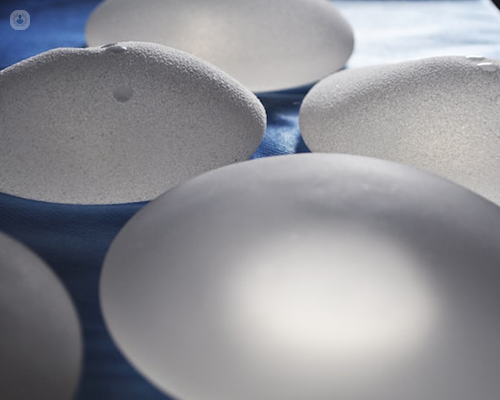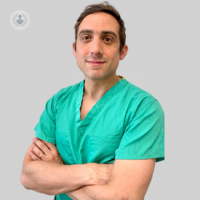An expert guide: Choosing breast implants for augmentation
Written by:With a wide range of breast implants available and many key factors to consider, choosing the right volume, surface, density and shape for you can be tricky. In this informative guide for patients, highly respected consultant breast surgeon Mr Andrew Pieri shares his expert insight on the most important factors to consider when selecting breast implants for a breast augmentation.

Implant volume: How should I choose the size of my implants?
We measure implant volume in cubic centimetres (cc), which is exactly the same as millilitres (ml). For instance, a 300cc implant would be exactly the same volume as 300ml of water poured into a jug.
The best way to get an idea of which implant volume you want to go with is to use an implant sizing kit in clinic. You can use different sized implant inserts which go into the bra and allow you to visualise exactly what it would look like to have that volume of implant. This usually gives the surgeon a range of volumes that you feel would be appropriate for you, so for example, the upper limit being around 330cc and a lower limit of 270cc. This gives us a little bit of wiggle room to adapt around other factors while ensuring you get the volume that is right for you.
Implant surface texture: How do smooth and textured implants differ?
Implant surfaces range from being very textured to completely smooth. There are two main advantages to a more textured surface. Firstly, in implants with some texture, there is some evidence to suggest that they cause less capsular contracture or that it takes longer for capsular contracture to occur.
Secondly, the grippier texture means that the implant is less likely to rotate inside the pocket because it can grip the tissue slightly better - almost like a Velcro texture. Rotation is a potential problem with anatomical (teardrop shaped) implants as they are not symmetrical. However, round implants are the same shape all the way around, so any rotation doesn’t change the appearance of the breast.
The grippy surface of a textured implant also helps to counteract gravity. When that implant is sitting in place in its pocket, gravity is pushing the implant down and this can lead to a complication known as ‘bottoming out’, where the implant manages to drop below where the bottom of the breast should be. The extra surface texture of the implant gives some resistance which can help to prevent this.
The main downside to having heavily textured implants is unfortunately quite serious. Anaplastic large cell lymphoma (ALCL) is a type of cancer that is caused by breast implants. It’s thankfully rare, with a risk of around one in twenty-five thousand but it is certainly highly associated with implants that have this very rough texturing on the surface. I feel that this risk heavily outweighs the benefits of heavy textured implants and therefore I no longer recommend them.
Some more modern textured implants are microscopically textured (termed nanotextured surfaces). These potentially offer the best of both worlds, although the evidence isn’t strong enough as there haven’t yet been enough cases. However, going forward they may be associated with less or no ALCL and might also offer some benefits in terms of reduced capsular contracture and bottoming out compared to smooth implants.
Implant shape: How do teardrop and round implants differ?
Round implants have a domed shape and are fully symmetrical. On the other hand, a teardrop, also known as an anatomical implant, has a top which is thinner than its bottom part, with most of the volume concentrated in its lower pole. Many people describe this as giving more of a natural look.
The main downside to a teardrop shaped implant is that if it rotates, this ruins the cosmetic effect and another operation would be needed to revise it. However, this can be countered to a large degree by rough texturing which makes the implant more grippy, but as previously discussed, we are moving away from using rougher textured implants towards smoother textured implants. Therefore, nowadays with modern implants, this becomes more of a risk that has to be carefully considered.
If a round implant is used, rotation is not an important factor as whichever way the implant rotates, it is symmetrical. With some of the modern round implants, we are finding that depending on the gel filling, most of the volume drops into the bottom part of the implant when it is held vertically, which mimics a teardrop shape. Many people describe the teardrop (anatomical) implants as appearing more natural-looking, but I feel that with modern round implants, that’s not necessarily such a key factor. As such, I predominately tend to use round implants because I think they give a natural appearance and they don’t need to be heavily textured to try and prevent rotation.
Implant dimensions: How can this affect the final look?
Although some implants may have the same volume, 120cc for example, they can differ greatly in terms of their width and projection. Some implants may wider but less projected (with a lower profile), while others of the same volume may be more projected but not as broad.
Despite having the same volume, the final look achieved with surgery can differ greatly as a result of these variations in implants. An implant which is deeper and not as broad will give a much more projected look and the appearance of a fuller cleavage, particularly in someone with a narrower chest, or what we call the base plate. On the other hand, a wider implant with a lower profile, will give a more natural look, with the volume being spread out across the breast and with less nipple projection.
Visit Mr Pieri’s Top Doctors profile to see his selection of videos with visual examples of different types of breast implant.
If you are considering a breast augmentation procedure and wish to schedule a consultation with Mr Pieri, you can do so by visiting his Top Doctors profile.


